Societe des Automobiles Aries, 51, Avenue cr Antin, Paris.
Page 12
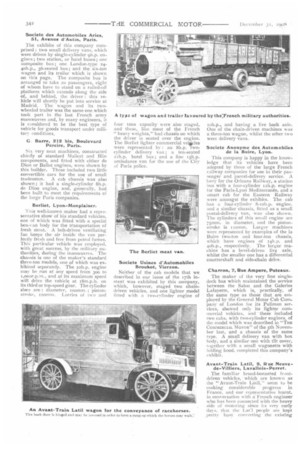
Page 13
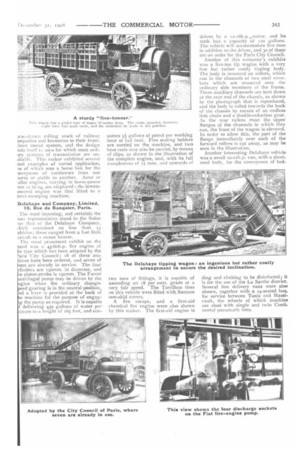
Page 14
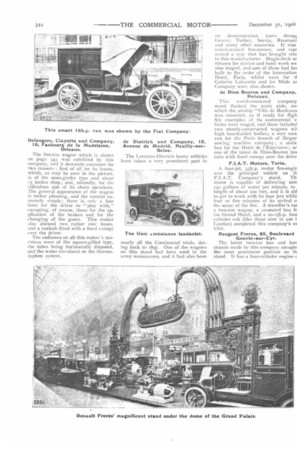
Page 15
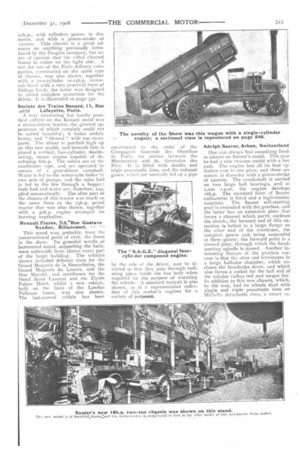
Page 16
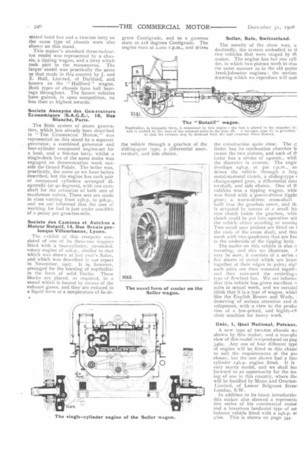
If you've noticed an error in this article please click here to report it so we can fix it.
The exhibits of this company comprised: two small delivery vans, which were driven by single-cylinder 9h.p. engines; two station, or hotel buses ; one composite bus ; one London-type 244oh.p., 36-seated bus; and the six-ton wagon and its trailer which is shown on this page. The composite bus is arranged to take zo passengers, eight of whom have to stand on a railed-off platform which extends along the side of, and behind, the driver : this vehicle will shortly be put into service at Madrid. The wagon and its twowheeled trailer was the same one which took part in the last French army manmuvres and, by many engineers, it is considered to be the best type of vehicle for goods transport under military conditions,
G. Barre, 212 bis, Boulevard Pereire, Paris.
Six very neat machines, constructed chiefly of standard Malicet and Blin components, and fitted with either de Dion or Ballot engines, were shown by this builder. These included two little convertible cars for the use of small tradesmen. A cab chassis was also shown ; it had a single-cylinder 8h.p. de Dion engine, and, generally, had been built to meet the requirements of the large Paris companies.
Berliet, Lyon-Monplaiser.
This well-known maker had a representative show of his standard vehicles, one of which was fitted with a special box-van body for the transportation of fresh meat.. A belt-driven ventilating fan keeps the air inside the van perfectly fresh and free from petrol fumes. This particular vehicle was employed, with great success, by the military authorities, during the maraeuvres. The chassis is one of the maker's standard three-ton r models, one of which was exhibited separately. The 22h.p. engine may be run at any speed from 300 to 1,000r.p.m., and at its maximum speed will drive the vehicle at 18m.p.h. on its third or top-speed gear. The cylinder sizes are : diameter, momm. ; piston stroke, 120111111, Lorries of two and four tons capacity were also staged, and these, like most of the French " heavy weights," had chassis on which the driver is seated over the engine. The Berliet lighter commercial vehicles were represented by : an 8h.p. Iwocylinder delivery van ; a ten-seated 221-1.p. hotel bus ; and a fine ish.p. ambulance van for the use of the City of Paris police.
Societe Usines d'Automobiles Broukot, Vierzon.
Neither of the cab models that we described in our issue of the 17th instant was exhibited by this company, which, however, staged two chaindriven vehicles, and one lighter model fitted with a two-cylinder engine of
toh.p., and having a live back axle. One of the chain-driven machines was a three-ton wagon, whilst the other two were delivery vans.
Societe Anonyme des Automobiles de la Buire, Lyon.
This company is happy in the knowledge that its vehicles have been adopted by three of the large French railway companies for use in their passenger and parcel-delivery set-vice. A lorry for the Orleans Railway, a station bus with a four-cylinder 12h.p. engine tor the Paris-Lyon Mediterranee, and a smart cab for the Eastern Railway were amongst the exhibits. The cab has a four-cylinder 8-toh.p. engine, and a similar chassis, fitted as a small postal-delivery van, was also shown. The cylinders of this small engine are 75mm. in diameter, and the piston. strokeis x iomm. Larger machines were represented by examples of the la Buire two-ton and four-ton chassis, which have engines of 1411.1). and 4oh.p., respectively. The larger machine has a bevel-driven live axle, whilst the smaller one has a differential countershaft and side-chain drive.
Charron, 7, Rue Ampere, Puteaux.
The maker of the very fine singledeck bus which maintained the service between the Salon and the Galeries Lafayette, which is, practically, of the same type as those that are employed by the General Motor Cab Company of London for its Pullman services, showed only its lighter commercial vehicles, and 'these included two cabs, with two-cylinder engines, of the model which was described in "THE COMMERCIAL MOTOR" of the sth November last, and a chassis of the same type. A small delivery van with box body, and a similar one with tilt cover, together with a small wagonette with folding hood, completed this company's exhibit.
Avant-Train Latil, 9, Rue Neuve de-Villiers, Lavallois-Perret.
The familiar broad-bonneted frontdriven vehicles, which are known as the "Avant-Train Latil," seem to be making considerable progress in France, and our representative learnt, in conversation with a French engineer who has been connected with the heavy side of motoring since its very early days, that the LatT1 people are kept .pretty bps-v converting the existing ›rs‹.-drawn rolling stock of railway llnpanies and breweries to their frontriven motor system, and the design nds itself to uses for which most ordiary systems of transmission are untitable. `lids maker exhibited several ood examples of varied application, rte of which was a horse box for the )nveyance of racehorses feotn one 3urse or stable to another. Aster or ;allot engines, varying in horse-power OTI1 12 to 24, are employed : the lowestowered engine was that fitted to a treet-sweeping machine.
Delahaye and Company, Limited, 10, Rue du hanquier, Paris.
The most imposing, and certainly the lost representative stand in the Salon /as that of the Delahaye Company, ;hich contained no less than 13 ehicles ; these ranged from a fast axicab to a motor hearse.
The most prominent exhibit on the tand was a 45-6oh.p. fire engine of e type which has been adopted by the aris City Council; 18 of these matines have been ordered, and seven of tem are already in service. The four 'finders are 130mm. in diameter, and le piston-stroke is isomm. The Farcot entrifugal pump may be driven by the ngine when the ordinary change
ed gearing is in the neutral position, nd a lever is provided at the back of c machine for the purpose of engagg the pump as required. It is capable f delivering 450 gallons of water per lin ute to n height of 165 feet, and con sumes 51 gallons of petrol per working hour at full load. Five scaling ladders are carried on the machine, and two hose reels may also be carried, by means of clips, as shown in the illustration of the complete engine, and, with its full complement of Is men, and upwards of
two tons of fittings, it is capable of ascending an t8 per cent. grade at a very fair speed. The Torrilhon tires on this vehicle were fitted with Samson non-skid covers.
A fire escape, and a first-aid chemical fire engine were also shown by this maker. The first-aid engine is
driven by a z2-16h.p.4motor, and its tank has a capacity of (20 gallons. The vehicle will accommodate five men in addition to the driver, and 30 of them are on order for the Paris City Council.
Another of this company's exhibits was a five-ton tip wagon with a very fine but rather costly tipping body. The body is mounted on rollers, which run in the channels of two steel members which are mounted over the ordinary side members of the frame. These auxiliary channels are bent down at the rear end of the chassis, as shown by the photograph that is reproduced, and the body is rolled towards the back of the chassis by means of an endless link chain and a double-reduction gear. As the rear rollers meet the upper flanges of the channels in which they run, the front of the wagon is elevated. In order to allow this, the part of the flange immediately over each of the forward rollers is cut away, as may be seen in the illustration.
Another interesting Delahaye vehicle was a small to-12h.p. van, with a sheetsteel body, for the conveyance of bed
ding and clothing to be disinfected; it is for the use of the La Sarthe district. Several fine delivery vans were also shown, together with a 4-seated bus, for service between Tunis and Massicault, the wheels of which machine are shod with single and twin Conti. nental pneumatic tires. Delaugere, Clayette and Company, 16, Faubourg de la Madeleine, Orleans.
The five-ton wagon which is shown on page 343 was exhibited by this company, and it demands comment for two reasons : first of all for its frame, which, as may be seen in the picture, is of the open-girder type and about 15 inches deep ; and, seeondly, for the ridiculous size of its chain sprockets. The general appearance of the wagon is rather pleasing, and the control extremely simple; there is only a foot lever for the driver to " play with," excepting, of course, those for the application of the brakes and for the changing df the gears. This maker also showed two rather nice buses, and a taxicab fitted with a fixed canopy over the driver.
The radiators on all this maker's machines were of the square-gilled type, he tubes being horizontally disposed, and the water circulated on the thermosyphon system. de Dietrich and Company, 12, Avenue de Madrid, Neuilly•sur Seine.
The Lorraine-Dietrich heavy vehicles have taken a very prominent part in nearly all the Continental trials, dating back to 1897. One of the wagons on this stand had been used in the army manceuvres, and it had also been on demonstration tours throuf Greece, Turkey, Servia, Roumant and many other countries. It was travel-stained five-tonner, and repr sented a type that has brought crec to this manufacturer. Single-deck or nibuses for station and hotel work we also staged, and one of these had bet built to the order of the Internation Hotel, Paris, whilst vans for ti Galeries Lafayette and for Miele ar Company were also shown.
de Dion Bou ton and Company, Put eaux.
This world-renowned company stand flanked the main aisle, A four-jet, 35h.p. motor fire-engir was the principal vehicle on di F.I.A.T. Company's stand. Thl motor is capable of delivering sorn 250 gallons of water per minute, to height of about 200 feet, and it is abl to get to work with its four jets withi four or five minutes of its arrival o the scene of the fire. A traveller's cat two-ton wagon, a to-seated bus fc the Grand Hotel, and a ro-rsh.p. foui cylinder cab (like those now in use i London) completed this company's hibit. Peugeot Freres, 83, Boulevard Gouvin -surCyr. The latest two-ton bus and lorr chassis made by this company occupie the most prominent position on th stand. It has a four-cylinder engine c 22h.p., with cylinders omm. in diameter, and with a piston-stroke of 120111M. This chassis is a great advance on anything previously introduced by the Peugeot company, but we are of opinion that the rolled channel frame is rather on the light side. A van for one of the Paris delivery companies, constructed on the same type of chassis, was also shown, together with a two-cylinder To-T4h.p. motor. cab fitted with a very practical form of folding hood; the latter was designed to afford complete protection for the driver. It is illustrated on page 332. Societe des Trains Renard, 11, Rue Ain Lafayette, Paris. A very interesting but hardly practical exhibit on the Renard stand was a steam-driven tractor, the general appearance of which certainly could not be called beautiful; it looks unduly heavy, and "blessed " with too many parts. The driver is perched high up on this new model, and beneath him is placed a vertical, four-cylinder, doubleacting, steam engine capable of developing 6oh.p. The valves are ot the mushroom type, and are operated by means of a gear-driven camshaft. Water is fed to the water-tube boiler bv two sets of pumps, and the coke fuel is fed to the fire through a hopper; both fuel and water are, therefore, supplied automatically. The after part of the chassis of this tractor was much on the same lines as the 75h.p. petrol tractor that was also shown, together with a 5oh.p. engine arranged for burning napthaline. Renault Freres, 115,'Rue Gustave Sandoz, Billancourt. ..,•>... This stand was, probably, from the constructional point of view, the finest in the show. Its graceful scrolls of hammered metal, supporting the facia, were noticeable from almost every part of the large building. The vehicles shown included delivery vans for the Grand Magasin de la Samaritaine, the Grand Magasin du Louvre, and the Bon Marche, and omnibuses for the Hotel Saint Laurent and the Elysee Palace Hotel, whilst a new vehicle, built on the lines of the London Pullman buses, was also shown. The last-named vehicle has been con s fru cod to the order of the Compagnie Generale des Omnibus de Paris. for service between the Montmartre and St. Germaine des Pres. It Is fitted with double and triple pneumatic tires, and the exhaust gases, which are normally led up a pipe by the side of the driver, may be diverted so that they pass through radiating pipes inside the bus body when required for the purpose of warming the vehicle. A standard taxicab is also shown, as is a representative collection of this maker's engines for a variety of purposes. Adolph Saurer, Arbon, Switzerland One can always find something fresh to admire on Saurer's stand. This year he had a new two-ton model with a live axle. The engine has all its four cylinders cast in one piece, and these are oomm. in diameter with a piston-stroke of I20MM, The crankshaft is carried on two large ball bearings, and at i,000 r.p.m. the engine develops 18h.p. The standard form of Saurer carburetter is fitted and a high-tension magneto. The Saurer self-starting gear is embodied with the gearbox, and the latter has an extension piece that forms a channel which partly encloses the clutch; the forward end of this extension is bolted to a large flange on the after end of the crankcase, the complete power unit being suspended at three points; the forward point is a pivoted joint, through which the handstarting spindle is passed. Another interesting feature of the gearbox carcase is that the after end terminates in a large buIbular chamber, which encloses the foot-brake drum, and which also forms a socket for the ball end of the tubular radius rod and torque bar. In addition to this new chassis, which, by the way, had its wheels shod with single and triple pneumatic tires on Michelin detachable rims, a smart 12 seated hotel bus and a two-ton lorry on the same type of chassis were also shown on this stand. This maker's standard three-to-fourton model was represented by a chassis, a tipping wagon, and a lorry which took part in the manceuvres. The larger model was practically the same as that made in this country by J. and E. Hall, Limited, of Dartford, and known as the " Hallford " wagon. Both types of chassis have ball bearings throughout. The Saurer vehicles have gained, in open competition, no less than 2/ highest awards. Societe Anonyme des Gen erateurs Economiques (S.A.G.E.), 18, Rue Blanche, Paris. The Stolz system of steam generation, which has already been described in "THE COMMERCIAL MOTOR," was represented on this stand by a separate generator, a combined generator and four-cylinder compound engine-set for a boat, and a five-ton lorry, whilst a single-deck bus of the same make was engaged on demonstration work outside the Grand Palais. The boiler was, practically, the same as we have before described, but the engine has each pair of compound cylinders arranged diagonally (at 90 degrees), with one camshaft for the actuation of both sets of mushroom valves. These sets are made in sizes varying from 251.1.p. to 5oh.p., and we are informed that the cost of working for fuel is just under one-fifth of a penny per g-ros-ton-mile. Societe des Camions et Autobus a PAoteur Rotatif, 14, Rue Bruais prolongue Villeurbanne, Lyons. The exhibit of this company consisted of one of its three-ton wagons fitted with a four-cylinder, air-cooled, rotary engine of 2oh.p., similar to that which was shown at last year's Salon, and which was described in our report in November, 1907. It is, however, arranged for the burning of napthaline in the form of solid blocks. These blocks are placed, as required, in a vessel which is heated by means of the exhaust gases, and they are reduced to a liquid form at a temperature of 6o de grees Centigrade, and to a gaseous state at 218 degrees Centigrade. The engine runs at 2,000 r.p.m., and drives the vehicle through a gearbox of the sliding-gear type, a differential countershaft, and side chains. Soller, Bale, Switzerland. The novelty of the show was, u doubtedly, the system embodied in ti two vehicles that were staged by th maker. The engine has but one cyli der, in which two pistons work in mw the same manner as in the old pattet Ai-rot-Johnston engines : the section. drawing which we reproduce will mal the construction quite clear. The tinder has its combustion chamber b. tween the two pistons, and each of t1.latter has a stroke of 14omm., whit: the diameter is 210mm. The engir develops 24h.p. at soo r.p.m., an drives the vehicle through a larg metal-to-metal clutch, a sliding-type change,-speed gear, a differential cow tershaft, and side chains. One of tlexhibits was a tipping wagon, whic was fitted with a power-driven tippin gear; a worm-driven cross-shaft built into the gearbox cover, and th is actuated by means of a small fri. tion clutch inside the gearbox, whic clutch could be put into operation wit the vehick either standing or movir4 Two small spur pinions are fitted on 1 the ends of the cross shaft, and theE mesh with two quadrants that are fixe to the underside of the tipping body. The cooler on this vehicle is also ii teresting, and this we illustrate. .4 may be seen, it consists of a series < flat sheets of metal which are braze together at their edges in pairs; eigl such pairs are then mounted togeth. and they surround the centrifuga type of flywheel fan. We are informe that this vehicle has given excellent I-. suits in actual work, and we certain] think that it is a type of wagon, whict like the English Broom and Wade, ' deserving of serious attention and ch velopment, with a view to the produi tion of a low-priced, and highlv-eft cient machine for heavy work. Unic, 1, Quai National, Puteaux. A new type of two-ton chassis wr. shown by this maker, and a rear-pla view of tills model is reproduced on pag 346a. Any one of four different type of engine will be fitted to this chass] to suit the requirements of the put chaser, but the one shown had a foot cylinder 24h.p. engine fitted. It is very sturdy model, and we shall loo forward to an opportunity for the tes ing of one in this country, where the will be haddled by Mann and Overton! Limited, of Lower Belgrave Street London, S.W. In addition to its latest introductior this maker also showed a representz tive series of his commercial motor and a luxurious landaulet type of air bulance vehicle fitted with a 24h.p. er gine. This is shown on Page 344.






















